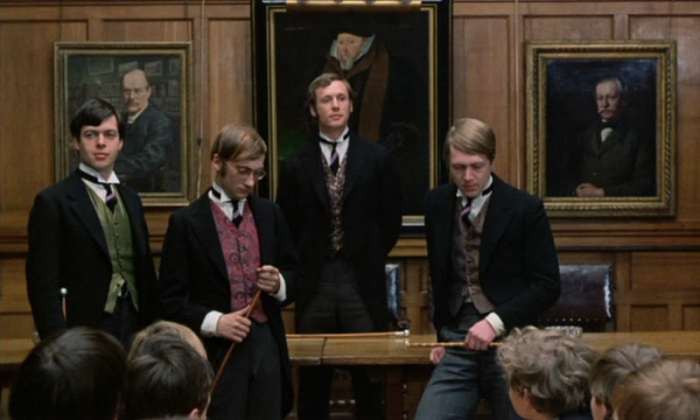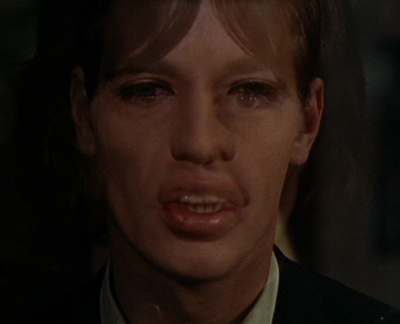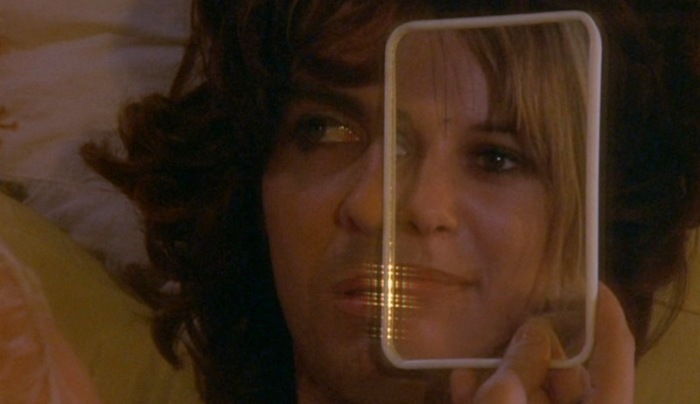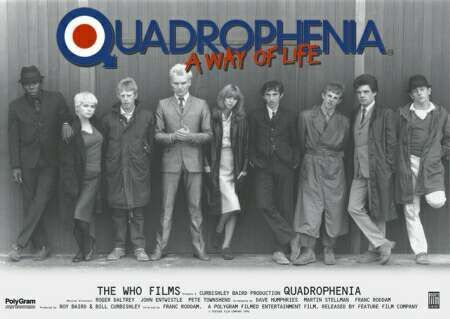(N.B this, with a little judicious editing, is taken from my old blog.)
I’m not really a film buff. The films I really like I watch over and over again, sucking the marrow out of them as you would with a good album or novel, but rare is the movie which repays that close attention. Generally (but not always), the ones I get obsessed by are British. Not that Hollywood doesn’t produce some good films – Fight Club, Pulp Fiction, Chinatown and so on – but the best British films seem to be more truthful, more lifelike, where the best American films seem more stylised. Films like Personal Services, Get Carter, Kes, Scum, Withnail and I, Trainspotting, Wish You Were Here, Rita, Sue and Bob Too, hell, even Educating Rita, capture a reality I relate to far easier than any other films. (I know there are large amounts of British-made pish, but I’m talking about the best ones, as compared with the best American or French films for example. I’m not going to defend The Sex Lives of the Potato Men).
So here then are my top three:
This is my favourite youth-orientated film of all-time. It’s the film of The Who’s 1973 concept album of the same name, the story of Jimmy, a mod, who is unsure of his identity and subsumes his own within the mod movement. Mods, of course, were the youth culture of the day, who dressed sharp, took speed in the form of pills called purple hearts and blues, rode Vespa scooters and listened to sharp modern pop. They were in opposition to, and antagonistic towards rockers, who rode larger motorbikes, wore leather and idolised fifties rock like Eddie Cochran and Gene Vincent. Being a mod gives Jimmy a sense of identity at a time (he must be seventeen or so) when you are unsure of yourself and need to fit in: but this comes at a cost, as Jimmy eventually finds.
Amongst the numerous qualities of this film is a absolute dedication to the reality of the context. There are no compromises in setting, dialogue or tone. The strong London accents are undiluted, giving some memorable exchanges, such as “Feel asleep on the train and waahnd up in bloody Neasden!” or “The people who ride these things are state, third-class tickets.” Similarly, the setting is unvarnished but completely recognisable as a working-class environment: Jimmy’s home is a plain council house, with crude newspaper cut-outs adorning his bedroom wall and evidently no bath. The scene where Jimmy sleeps out in their shed and just misses his dad leaving for work, with flat cap and wax jacket, is tiny but acutely detailed, which goes for the film throughout.
Despite this verite, there is a depth to the film which is constantly dramatising larger themes. The way it does this using everyday dialogue is just amazing, and a real lesson: you don’t need to be “educated” to have ideas, you don’t need to have upper-class characters to illustrate larger issues. (James Kelman, the greatest writer Scotland has produced since Lewis Grassic Gibbon, was no doubt taking notes). To take one example: we see Jimmy paying another HP installment on his suit (no store cards in those days – and where else have you ever seen such a frank depiction of the realities of consumer spending for the young?). As he pays, another mod and his friend is being measured for a suit, angrily querying the tailor, insisting it be made much tighter and sharper. “Stop fuckin around and bring it in ere!” To which the agitated tailor loses his temper, insisting, “Look here, sonny! You keep that kind of language to yourself! You don’t like it, you can go and get your own suit.” The mod asks his friend what he thinks. “Fucking rent-a-tent, innit.” The tailor looks angry but does nothing; he doesn’t want to lose the sale. There, in a nut-shell, are big themes like Youth Consumption and Generation Clash and Consumerism.
Or to take another scene: a former school friend Kevin, now a rocker (the enemy) pays Jimmy a visit, biking up Jimmy’s garden path. Jimmy is in the shed tinkering with his scooter, and hearing the deep thrum of the bike and fearing assault, picks up a spanner. They talk about why one is a mod, one is a rocker. The conversation is just brilliant:
Jimmy: But it’s not just the bikes, it’s the people. And the people who ride these things [gestures to Kevin’s motorbike] are states, third-class tickets.
Kevin: Do what?
Jimmy: Rockers, all that greasy hair and clobber. It’s diabolical!
Kevin: I don’t give a monkey’s arsehole about mods and rockers. Underneath, we’re all the same, ain’t we?
Jimmy: Nah, Kev, that’s it. I don’t wanna be the same as everybody else. That’s why I’m a mod, see? I mean, you gotta be somebody, ain’t ya? Or you might as well jump in the sea and drown.
Kevin: That’s why I joined the army: to be different. To get away from all this! But wherever you go, there’s always some cunt in stars and stripes who wants to push you about.
God, that’s great. Identity, conformism, ambition, belonging, group identity – all in one completely realistic conversation. (And the irony of going into the army to be different – delivered completely straight-faced, whereas any hamming it up would shatter your belief in the character).
So there’s all that. But I haven’t even mentioned the Brighton scene yet! This must be one of the most visceral scenes in all cinema – those fuckers are really beating each other up on that beach! It’s completely compelling, sheer euphoric teenage kicks: not just the fighting, but when they are “kettled” by the police into one small street, the battle cry of “We are the mods! We are the mods! We are, we are, we are the mods!” sets your hair on end. It’s just electric.
As with speed (which Jimmy is shown taking fairly often), or any stimulant, there’s the rush and then the hangover. So it is with Jimmy. After the amazing climax of Brighton, the rest of the film is an unravelling, as Jimmy finds being a mod can’t support a life. The euphoric camaraderie splits apart as soon as it achieved. Jimmy retraces his steps, unable to let go and clinging on to the mod identity. He returns to Brighton, but what was once alive with mods is now a sleepy resort. And once all his illusions are shattered, eventually he manages to let go. At the end he’s shown walking away from it all, alone.
Other things worthy of attention: the direction is excellent with the camera inobtrusive; you really do get the sense of watching a slice-of-life. It’s not flashy or showy, concealing its artfulness behind a self-effacing realism. The cast are terrific (a show-case for acting talent – Phil Daniels, Leslie Ash, Ray Winstone, Sting, Toyah Wilcox, Michael Elphick, and Benjamin Whitrow) with the characters well-sketched. You really get a sense of the group dynamic, the boys aiming for the leadership of the mod gang, and the top girl knowing it all too well.
Still not sure? Here’s a clip to prove it.
*
2. if…
 if… was famously filmed at the time of the evenements of May 68 in France – as the film is an allegory for revolution against the repressive, reactionary old-order, this was entirely fitting. (John Lennon was at the same time writing “Revolution” while meditating in India – clearly there was something in the air). It is also the first film of Malcolm MacDowell, and while he doesn’t steal the show (for a film almost entrely about boys who are actually played by boys, he cast is highly impressive), he does grab the attention.
if… was famously filmed at the time of the evenements of May 68 in France – as the film is an allegory for revolution against the repressive, reactionary old-order, this was entirely fitting. (John Lennon was at the same time writing “Revolution” while meditating in India – clearly there was something in the air). It is also the first film of Malcolm MacDowell, and while he doesn’t steal the show (for a film almost entrely about boys who are actually played by boys, he cast is highly impressive), he does grab the attention.
I said if… is an allegory of revolution – but the school is also an allegory of Britain, with its all from past glories, repression, incompetent, class-based leadership, absurd rules, appalling education, and gross archaic longings. It works remarkably well as a simple story of school boys revolting against repressive discipline (enforced by prefects called “whips” – a magnificent little detail), but almost every scene has a symbolic meaning. For example: one boy confessing to having “dirty thoughts” (presumably homosexual) to the Chaplain, who can offer no real advice – a condemnation of British sexual ignorance and hypocrisy. The new boy being told by a senior boy that “You don’t talk to us” and that the youngest boys are called “scum” – the power of seniority. The chaplain being (literally!) kept in a drawer in the headmaster’s office – the use of religion in controlling and disciplining the masses.
As suggested by the chaplain being in the drawer, the film flips between realism and surrealism. The realism is noteworthy – there’s no idealisation of the boys, who are no Hollywood lookers and the film looks frankly at bullying, public-school homosexuality, beatings, and pretentious pseudo-intellectualism, and the school itself is shabby and past its best. But remarkably this realism is commented upon by the surreality of some episodes, such as the schoolmaster’s wife wandering naked through the school (a comment on sexual repression and longing) and the encounter with “the girl”, especially the tiger-fight between her and Mick (the leader of the rebels, played by MacDowell). Similarly, while the pretty junior boy is realistically portayed as having older boys prey upon him, he is surrealistically seen in bed with one of the rebels, who had actually taken the time to talk to him.
The film itself similarly filps between colour and black and white. Don’t believe anyone who tells you that parts were shot to save money, as parts of the same scenes alternate. It’s another trick to break up the film, a Brechtian “alienation effect”, as with the realism/surrealism dialectic. Both add to and heighten the other.
The rebellion gradually gathers pace, once the school and the characters are established. (Viewers may note the pictures of revolutionaries pinned up throughout the boys rooms, such as Mao and Che – it was that kind of era). The end is obviously allegorical, ending on a freeze-frame of MacDowell raining down shots on the school and the gathered dignitaries. After Columbine this feels awkward to me, but no-one is suggesting that this should be taken literally. It’s a fantasy – that’s why the film is called if...
*
1. Performance
OK. The best British film ever is Performance from 1970, co-directed by Nic Roeg and Donald Cammel, and featuring (I’m loath to say “starring”) James Fox, Mick Jagger, Anita Pallenberg and some real East End heavies. (Let’s not get too public-school boy/Guy Ritchie excited about that – but they do add to a convincingly brutal opening half of a subsequently psychedelic film). It’s worth noting the directors, too: Roeg made his name as a cinematographer (Performance and his later films such as Walkabout and The Man Who Fell To Earth are highly arresting visually), whereas Cammel was a painter and writer soaked in Genet, Borges, Burroughs and London/Parisian bohemia.
Performance is a film where nothing is as it seems. It questions the various dualities which make up our culture: male and female, nature and culture, fantasy and reality, heterosexual and homosexual, interior and exterior, image and reflection. Obviously this isn’t a straightforward plot-driven film: it’s something of a diptych (a film in two distinct parts, jargon-fans), with a violent gangster opener and a psychedelic mind-fuck closer. The relation between the two sections of the film only gradually becomes apparent; texturally, cinematically, atmospherically they are completely different.
Performance is a master-class of cinematography. It is densely allusive, symbolically rich and eyeball-grabbing visually. I do not exaggerate when I say I have never seen a film like it; although Walkabout has some visual similarities, they are nothing alike in terms of theme and tone. Perhaps the real union of minds in Performance is not between Chas and Turner, but between Roeg and Cammel, the visual genius and the ideas man.
The plot is relatively straightforward (bearing in mind, this is not a plot-driven film). Chas (played by Fox) specialises in “putting the frighteners up flash little twerps” for his gangland boss. When he oversteps the mark and kills a fellow mobster, Chas goes on the run, hiding from “the firm”. He takes refuge in the basement flat of a reclusive faded pop star called Turner, played by Jagger, and his household of two women (played by Pallenberg and Michèle Breton) and one odd servant girl. The longer Chas stays in Turner’s house, and the more he interacts with the residents, the more his boundaries and sense of identity are unsettled, through mindgames and psychedelic mushrooms. But this works both ways, and the similarities between Chas and Turner become increasingly apparent, to the point where both share the same death.
Much of this is suggested visually rather than dramatised. For example, when Chas goes further into Turner’s house, seeking a telephone, this suggests his further entry into Turner’s world and mindspace. This is shown by a juxtaposition of their two faces whilst they talk, which evokes a deeply uncanny feeling.
 Similarly, there is a constant use of both mirrors and mirror images throughout the film, to suggest two things. Firstly, mirrors suggest the dualities such as male/female and fantasy/reality which are explored during the film. But secondly, mirrors symbolise the self-projection with which both Chas and Turner are fundamentally concerned, both being “performers”. Performance shows how the gangster and the rock star are all too similar in their masculine, violent displays, suggesting the male ego’s need for dominance and power, whether expressed sexually or through group dominance.
Similarly, there is a constant use of both mirrors and mirror images throughout the film, to suggest two things. Firstly, mirrors suggest the dualities such as male/female and fantasy/reality which are explored during the film. But secondly, mirrors symbolise the self-projection with which both Chas and Turner are fundamentally concerned, both being “performers”. Performance shows how the gangster and the rock star are all too similar in their masculine, violent displays, suggesting the male ego’s need for dominance and power, whether expressed sexually or through group dominance.
But Performance also critiques this, with Chas undergoing psychedelic initiation, altering his “image”, and having his masculinity and sexuality questioned. Pherber (played by Pallenberg) uses mirrors upon Chas, projecting his face upon hers, and having both faces side by side (see top photo), and asking if he has a male and female half, like Turner. Chas angrily replies, “There’s nothing wrong with me – I’m normal!”
 The film also plays with the androgyny of Lucy (played by Breton) and Turner: at one point we see Chas in bed caressing someone who appears to be Turner; a moment later it turns out to be Lucy. The recurrent tactic of dislocation (further heightened by the extremely jumpy editing) effectively suggests Chas’ disorientated mind.
The film also plays with the androgyny of Lucy (played by Breton) and Turner: at one point we see Chas in bed caressing someone who appears to be Turner; a moment later it turns out to be Lucy. The recurrent tactic of dislocation (further heightened by the extremely jumpy editing) effectively suggests Chas’ disorientated mind.
Further aspects of the film which merit mention for their imaginative use are the music, with some nice early synthesiser work, deep blues, rock and roll (the “Memo To Turner” scene, where Jagger sings to what is more like a conventional rock video, must be the only time where Warner Bros actually got what they wanted), proto-rap, and an eerily unsettling orchestral finale. The editing, as mentioned above, is extremely jumpy, so that you really have to watch the film a few times to understand what’s happening, as scenes intercut rapidly. Camera angles, in case you didn’t guess already, are somewhat extreme. All of which may seem somewhat overcooked, but Performance is one of those rare and happy times where content and method match exactly.
Obviously, Hollywood, this is not: the nearest comparison I can think of is Pink Floyd’s The Wall, a film which is similarly non-linear and told through images and music rather than narrative. But Performance is a far more literary film (with Borges being a major inspiration), where The Wall is naturally more musical, with next to no dialogue. And Performance captures a specific moment in British 60s culture, when the rock/drug subculture met with the criminal world, as embodied by the Kray twins (whereas The Wall captures Roger Water’s alienation and little else). The utopian dreams of 1967 would turn darker and more violent, reaching a deadly apothesis in Altamont in 1969.
Consequently, numerous myths have sprung up around Performance, also prompted by Pallenberg’s subsequent heroin addiction and Fox’s retreat from acting to door-knocking evangelical Christianity. (Jagger, typically, walked away unharmed, like a cat daintily leaving the scene of a carcrash). There was, too, the sticky matter of Jagger’s love-scene with Pallenberg being rather too graphic for Keith Richards, her then-partner. But this is essentially gossip. What we have a film which is both specific and timeless, literal and metaphorical, intensely visual and deeply literary, and ultimately an astonishing piece of cinema. That’s why it’s the best British film ever made.
